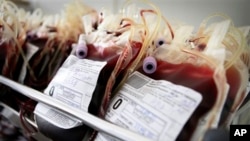GENEVA —
The World Health Organization says lack of access to safe blood is responsible for the deaths of hundreds of thousands of childbearing women each year.
In advance of World Blood Donor Day on June 14, WHO is calling for action to make safe blood supplies available to prevent maternal deaths.
According to WHO officials, about 800 women die each day from complications related to pregnancy and childbirth. Almost all of these deaths occur in developing countries, with more than half of them in sub-Saharan Africa and nearly one-third in South Asia.
WHO Coordinator for Blood Transfusion Safety Dr. Neelam Dhingra says most of these deaths can be prevented.
“Severe bleeding during pregnancy, delivery and after childbirth is the single biggest cause of maternal death and can kill a healthy woman within two hours if she is unattended," said Dhingra. "Urgent access to safe supplies of blood for transfusion is therefore crucial to saving the lives of these women. In many countries, blood supplies are inadequate and safe blood is not accessible when and where it is needed.”
Many communities are simply not aware of the importance of having a safe blood supply on hand, she adds, explaining that a paucity of voluntary, unpaid blood donors is another major reason behind the lack of adequate safe blood supplies.
“Many countries which have developed robust and strong blood systems, they have based it on voluntary, unpaid donations," she said. "It is also recognized that the infection prevalence is much lower in blood which is obtained from voluntary, unpaid blood donors. So there are issues related to safety, to security of supply, as well as ethical concerns.”
This conviction is so strong that past World Health Assemblies have adopted resolutions in which member states agree to develop national blood banks based on a voluntary, unpaid donor system.
The WHO reports about 108 million blood donations are collected worldwide annually. It says more than half of these are collected in wealthy countries, home to 18 percent of the world’s population.
While poor countries remain underserved, data show significant increases of voluntary unpaid blood donations in low-and middle-income countries. Between 2004 and 2012, WHO reports voluntary, unpaid blood donations in 162 countries increased by 8.6 million. The highest increase is recorded in South-East Asia followed by African regions.
WHO says countries that have successfully reduced maternal deaths by improving access to a safe blood supply include Cambodia, Nepal, Bangladesh, Zambia and Ethiopia.
In advance of World Blood Donor Day on June 14, WHO is calling for action to make safe blood supplies available to prevent maternal deaths.
According to WHO officials, about 800 women die each day from complications related to pregnancy and childbirth. Almost all of these deaths occur in developing countries, with more than half of them in sub-Saharan Africa and nearly one-third in South Asia.
WHO Coordinator for Blood Transfusion Safety Dr. Neelam Dhingra says most of these deaths can be prevented.
“Severe bleeding during pregnancy, delivery and after childbirth is the single biggest cause of maternal death and can kill a healthy woman within two hours if she is unattended," said Dhingra. "Urgent access to safe supplies of blood for transfusion is therefore crucial to saving the lives of these women. In many countries, blood supplies are inadequate and safe blood is not accessible when and where it is needed.”
Many communities are simply not aware of the importance of having a safe blood supply on hand, she adds, explaining that a paucity of voluntary, unpaid blood donors is another major reason behind the lack of adequate safe blood supplies.
“Many countries which have developed robust and strong blood systems, they have based it on voluntary, unpaid donations," she said. "It is also recognized that the infection prevalence is much lower in blood which is obtained from voluntary, unpaid blood donors. So there are issues related to safety, to security of supply, as well as ethical concerns.”
This conviction is so strong that past World Health Assemblies have adopted resolutions in which member states agree to develop national blood banks based on a voluntary, unpaid donor system.
The WHO reports about 108 million blood donations are collected worldwide annually. It says more than half of these are collected in wealthy countries, home to 18 percent of the world’s population.
While poor countries remain underserved, data show significant increases of voluntary unpaid blood donations in low-and middle-income countries. Between 2004 and 2012, WHO reports voluntary, unpaid blood donations in 162 countries increased by 8.6 million. The highest increase is recorded in South-East Asia followed by African regions.
WHO says countries that have successfully reduced maternal deaths by improving access to a safe blood supply include Cambodia, Nepal, Bangladesh, Zambia and Ethiopia.








